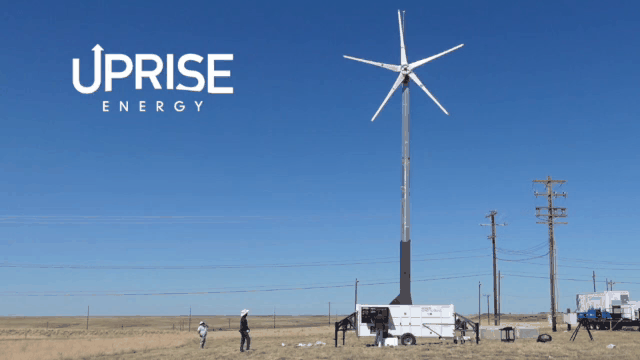
Comparing Costs and Carbon Dioxide Emissions of Diesel Generators vs Wind Turbines
chris@upriseenergy.com
chris@upriseenergy.com
Today we would like to share excerpts from an engineering report written by internal Uprise Energy staff. We thought it might be insightful for our readers to see that we are doing more than building Mobile Renewable Back-up Generators for government agencies (hint, hint, wink)!
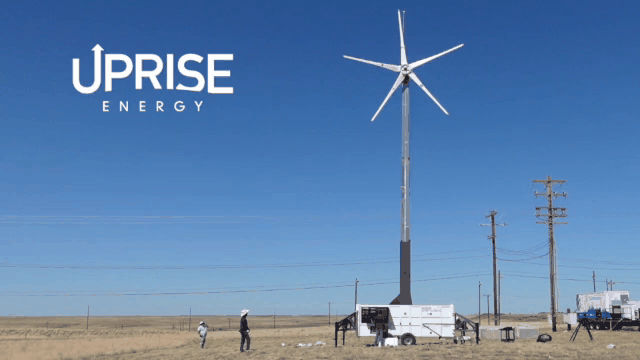
The Uprise Energy MPS in action at INL.
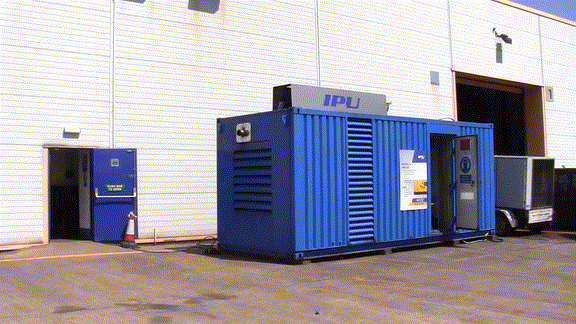
Diesel Generator in operation.
Using methodology approved by the U.S. Environmental Protection Agency's Science Advisory Board (SAB), the analysis finds that approximately 21,000 people die prematurely each year due to particulate matter pollution from diesels.
While there are differing views about the degree of impact that humans are having on Earth’s environment and what should be done about it, it is generally accepted that we do urgently need to alter the path we are on to reduce the volume of pollutants we produce. Carbon Dioxide (CO2) is the focus of this study.
CO2 is a naturally occurring greenhouse gas which is a requirement for life on this planet. Plants require CO2 for photosynthesis, and the process produces Oxygen, which animal life and people breathe in exchange for CO2, and the cycle repeats. However, when there is an overabundance of CO2 it causes problems with the Earth's ability to shed heat. Ever since the industrial revolution (circa late 1700s) we have been generating an increasing amount of CO2, and this has created a significant imbalance.
Brian, an engineer on our team, wrote a report analyzing the benefit of replacing a diesel generator with one of our Mobile Power Stations (MPS), and the positive impact it has on the environment. This post will consist of both written narrative and mathematics from this report. We hope it has a little something to interest everyone.
The impetus for this report was a question: “If you used an Uprise Mobile Power Station instead of a diesel generator, how many trees would it take to match the carbon offset?” In other words, diesel generators emit a significant amount of carbon dioxide in the process of generating electricity; the Mobile Power Station, on the other hand, generates carbon-free electricity. Therefore, how many trees would it take to absorb an equivalent amount of carbon dioxide as would be saved when generating electricity from a Mobile Power Station instead of a diesel generator? Internally, we performed a thorough study to answer this question which resulted in a comprehensive Engineering Report.
We are sharing excerpts of the engineering report in this blog post. The indented and italicized text is from the report with minor formatting edits done so that it reads better in blog format. References cited in the engineering report are available at the end of the post, and noted with brackets [ ].
Let’s begin with an overview of the global diesel generator market:
The global portable diesel generator market size was $3.88 billion in 2018 and is projected to reach $5.87 billion by 2026, with a Compound Annual Growth Rate (CAGR) of 5.4%. The Asia – Pacific market forecast is shown in Figure 1 [2]. The numerical figures shown are in $1,000,000,000 USD units.

Figure 1: Asia-Pacific Portable Generator Market, 2015 – 2026 (USD Billion)
Other models show the world market demand for diesel generators at 350 to 500 Gigawatts. [3]
For reference, the average US home uses 1 kilowatt per hour and 1 Gigawatt equals 1000 kilowatts or enough power for 1000 US homes. To furthur punctuate this, 1 GW is also the equivalent of 110 million LEDs or roughly 1.3 million horses (more comparisons here). Hopefully, this gives some perspective of the sheer magnitude of 350 - 500 GW of electricity. Generating that much energy with diesel generators burns a tremendous amount af fuel, which produces pollutants as a byproduct, including carbon dioxide (CO2).
Diesel fuel is a complex mix of hydrocarbons, with an average composition of C12.9H23.9 and molecular weight of 178.6 [4]. Therefore, diesel fuel is 86.6% carbon, and 13.4% hydrogen.
A carbon atom has a weight of 12, and each oxygen atom has a weight of 16, giving each single molecule of CO2 an atomic weight of 44 (12 from carbon and 32 from oxygen).
Therefore, to calculate the amount of CO2 produced from a gallon of diesel, the weight of the carbon in the diesel fuel is multiplied by 44 / 12 or 3.7.
Since diesel is about 87% carbon and 13% hydrogen by weight, the carbon in a gallon of diesel weighs 5.5 pounds (6.3 lbs. x .87).
Multiply the weight of the carbon (5.5 pounds) by 3.7, which equals 20 pounds of CO2 per gallon of diesel fuel burned [5].
The above calculation is nearly identical for gasoline, with negligible difference.
The next task is to determine the amount of gallons of diesel that the Uprise Energy MPS can offset.
For a 5.5 m/s (12.3 miles per hour) wind, the predicted electric power for Uprise Energy’s rotor is 1.5 kW [6].
Uprise Energy’s proprietary “Dancing with the Wind“ technology is able to extract 1.65 times the energy available in a steady wind, due to wind variability [7].
The total Annual Energy Output is shown in Equation 1:AEO = (1.5kW) (1.65) (8,760 hours) / year) = (21,681 kWh) / year
The distribution of wind speeds over time at particular site follows a bell shaped curve, with a Rayleigh distribution [8, p.36] as shown in Figure 2.

Figure 2: Rayleigh Distribution for Various Wind Speeds
The cube factor, or Energy Power Factor, of a Rayleigh distribution is 1.91 [8, p.36]
As an assumption, diesel generators output 5 kW per gallon of fuel, equating to 13% efficiency for the generator. The 13% efficiency is based on Lower Heating Value, as shown in the derivations section near the end of this blog post.
Incorporating the Energy Power Factor into Equation 1:AEO = (21,681 kWh) / year) (1.91) = 41,410 kWh / year
AEO is 41,410 kWh / year for an Uprise Energy MPS.
The fuel savings for a diesel generator per year is shown in Equation 2:(41,410 kWh / year) / (5 kWh / gallon) = 8,282 gallons / year
Now we know the amount of carbon dioxide produced by burning a gallon of diesel fuel (20 pounds), and the number of gallons a year utilizing an MPS will offset (8,282). The next step is to determine the equivalent number of trees worth of carbon dioxide that is offset.
As stated in Equation 2, an Uprise Energy MPS offsets 8,282 gallons of fuel per year. At 20 pounds of CO2 per gallon, this equals 165,000 pounds of CO2 per year, or 3.3 million pounds over a 20 year life span.
One tree absorbs 48 pounds of CO2 per year [9]. 165,000 pounds of CO2 per year is equivalent to 3,450 trees per year, or 69,000 tree offset over a 20 year life span.
Over a 20 year lifespan, replacing a similar output diesel generator with an MPS would be the equivalent of the amount of carbon dioxide that it would take 69,000 mature trees to remove naturally. That’s a lot of trees!
Brian continued his analysis with a cost analysis comparing the costs of a lifetime of operation of a diesel generator and an MPS.
Typical installation and operating costs of a diesel generator for a 20,000 hour life span for a remote village in Nepal is $0.87 per kWh, as shown in Table 1: [1]
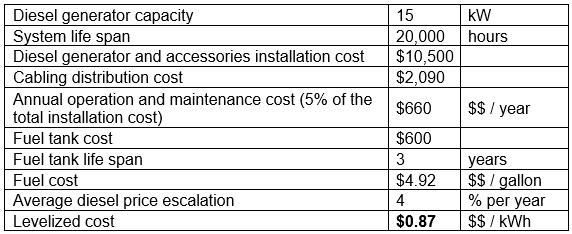
Table 1: Diesel Generator Operating Costs, 20,000 hour Diesel Generator Study
In Table 1, the “System Life Span” of 20,000 hours equates to 2.28 years at constant operation. From section 1.3, an assumption is 50% loading to account for variable loading through day and night. Utilizing a levelized cost of $0.87 per kWh for 20,000 hours of operation, the following conclusions are shown in Table 2. Total system cost of $130,500, including fuel:($0.87 / kWh) (15 kW) (50%) (20,000 hours) = $130,500 Total fuel costs of $115,000, based on 4% fuel cost increase per year. 7,500 gallons of fuel per year
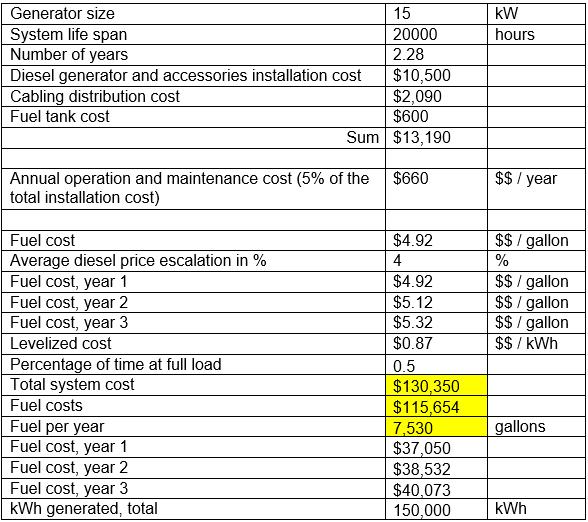
Table 2: Total System Costs for 20,000 hour Diesel Generator Study
The 20,000 hour study is projected out for 20 years of operation, as shown in Table 3.
Assumptions: $4.92 per gallon fuel cost in first year 4% fuel cost increase per year 7,500 gallons of fuel per year 8 diesel generators are needed 7 fuel tanks are needed The cabling and distribution costs do not increase from the 20,000 hour study to the 20 year projection.

Table 3: 20 year projection of 20,000 hour Diesel Generator Study
For a 20 year projection, the cost per kWh is $0.91, up from $0.87 in the 20,000 hour study.
The next step was analyzing fuel costs only, using Lower Heating Value (LHV). The derivations of Brake Specific Fuel Consumption (BSFC) and fuel efficiency used in the following equations are included at the end of this blog post.
The kW per gallon of fuel is shown in Equation 3:kW / gallon = (LHV / gallon) (1 kW / 3,412 BTU) (ηgen )
The lower heating value for diesel fuel is 128,500 BTU / gallon. [10]
From Equation 3:kW / gallon = (128,500 BTU) / gallon) (1 kW / 3,412 BTU) (13%) = 5 kW / gallon
For a fuel cost of $4.92 per gallon [1], this yields $0.98 per kW. If the diesel engine is run for one hour, the fuel cost is $0.98 per kWh.
The fuel cost of $0.98 per kWh using Lower Heating Value (LHV) compares to a fuel cost of $0.91 per kWh for the 20 year diesel generator projection, shown in Table 3.
From the previous formulas, a 10 kW Uprise wind turbine creates roughly 41,410 kWh per year. Therefore, the fuel savings alone would be greater than $40,000 per year.
$0.98 / (kWh) (41,410 kWh) / year) = $40,581 / year
Over 20 years, the fuel savings would be $800,000.
We at Uprise Energy take pride in using solid data to support our conclusions. A principal at Uprise has an expert understanding of this subject, and wants to say that the sited cost per kWh is an optimum case scenario.
There are more than a billion examples of small diesel engines being used to generate electricity that are using less efficient engines and alternators, operating under less than optimum loads, where the fuel has a higher cost, and therefore the cost per kWh could be double what this data indicates.
Our target market is not only those who can afford the best equipment.
There you have it. Replacing just one diesel generator with an Uprise Energy Mobile Power Station will reduce the same amount of carbon dioxide as 69,000 trees over a 20 year period, and save the user $800,000 or more.
So why so much focus on the trees? It’s a common thing to hear from people discussing the proper approach to environmental protection that carbon dioxide levels are not as urgent of a deal as many people make of it since trees (and other plant life, as well as the oceans) can naturally remove carbon dioxide from the air. While this is true, the task of reducing the imbalance of carbon dioxide we currently have is significantly beyond the capabilities of natural processes alone. It will also require the reduction of the generation of greenhouse gasses and other emerging technologies which can pull carbon dioxide from the air, and time, to get back to where we need to be.
We have designed the MPS to be utilized for distributed energy, off grid / grid edge solutions, humanitarian aid, emergency backup generation, and other industrial scenarios, to name a few. However, we are a renewable energy company first and foremost, and anything we do to help the current environmental situation while providing critical electricity is a victory to us.
Please feel free to provide feedback or ask us any questions you have about the content of this blog post in the comments. Thanks!
Derivations of Brake Specific Fuel Consumption (BSFC) and fuel efficiency used in previous equations:
The derivation of BSFC [11] is as follows:
Engine brake torque, TeTe = (nc Vd pme ) / (2πnr )
where
Te = engine brake torque, in Newton*meters nc = number of cylinders in engine Vd = volume of one cylinder, in cubic meters pme = mean effective pressure, in bar nr = number of rotations for a complete engine cycle, four stroke = 4
Effective engine powerPe = rpm (2π / 60) (Te )
where
Te = Engine brake torque, in Newton*meters Pe = effective (brake) engine power, in Watts
Brake Specific Fuel Consumption (BSFC)BSFC = mf / Pe (3,600)
Where BFSC in grams / kWh mf = fuel mass flow rate, in grams per second Pe = effective (brake) engine power, in kW
Fuel efficiencyηfuel = 1 / (BSFC*QLHV)
Where QLHV = lower heating value of fuel, in kWh / gram
References:[1] B. D. R. Mainali, "Isolated and Mini-Grid Solar PV Systems," 2015. [Online]. Available: https://www.sciencedirect.com/topics/engineering/diesel-generator. [Accessed 7 May 2020].[2] Fortune Business Insights, "Portable Generator Market Size, Share and Global Trend by Fuel (Diesel, Gas, and Others), Power Rating (Below 5kVa, 5-15 kVa, 15-45 kVa, 45-75 kVa), By Application (Residential, Commercial, and Others), and Regional Forecast, 2019 to 2026," 1 March 2020. [Online]. Available: https://www.fortunebusinessinsights.com/industry-reports/portable-generator-market-100155. [Accessed 23 June 2020].[3] International Finance Corporation, "Dirty Footprint of a Broken Grid," September 2019. [Online]. Available: http://documents.worldbank.org/curated/en/640791573016682618/pdf/Summary.pdf. [Accessed 7 May 2020].[4] C. Soares, Gas Turbines (Second Edition), 2015.[5] Fuel Economy, "How can a gallon of gasoline produce 20 pounds of carbon dioxide?," 29 October 2014. [Online]. Available: https://www.fueleconomy.gov/feg/contentIncludes/co2_inc.htm. [Accessed 4 May 2020].[6] Uprise Energy, "Aerodynamic Performance of Wetzel designed blades," Uprise Energy, San Diego, 2020.[7] Uprise Energy, "Relative kinetic energy in steady wind versus variable wind, “Dancing with the Wind”," Uprise Energy, San Diego, 2020.[8] P. Gipe, Wind Power, White River Junction, VT: Chelsea Green Publishing Company, 2004.[9] CO2meter.com, "Could Global CO2 Levels be Reduced by Planting Trees?," 29 October 2018. [Online]. Available: https://www.co2meter.com/blogs/news/ could-global-co2-levels-be-reduced-by-planting-trees. [Accessed 7 May 2020].[10] Alternative Fuels, "Fuel Comparison Chart," 29 October 2014. [Online]. Available: https://afdc.energy.gov/fuels/ fuel_comparison_chart.pdf. [Accessed 7 May 2020].[11] A. Stark, "Brake Specific Fuel Consumption (BSFC)," 19 August 2017. [Online]. Available: https://x-engineer.org/automotive-engineering/internal-combustion-engines/performance/brake-specific-fuel-consumption-bsfc/. [Accessed 11 May 2020].